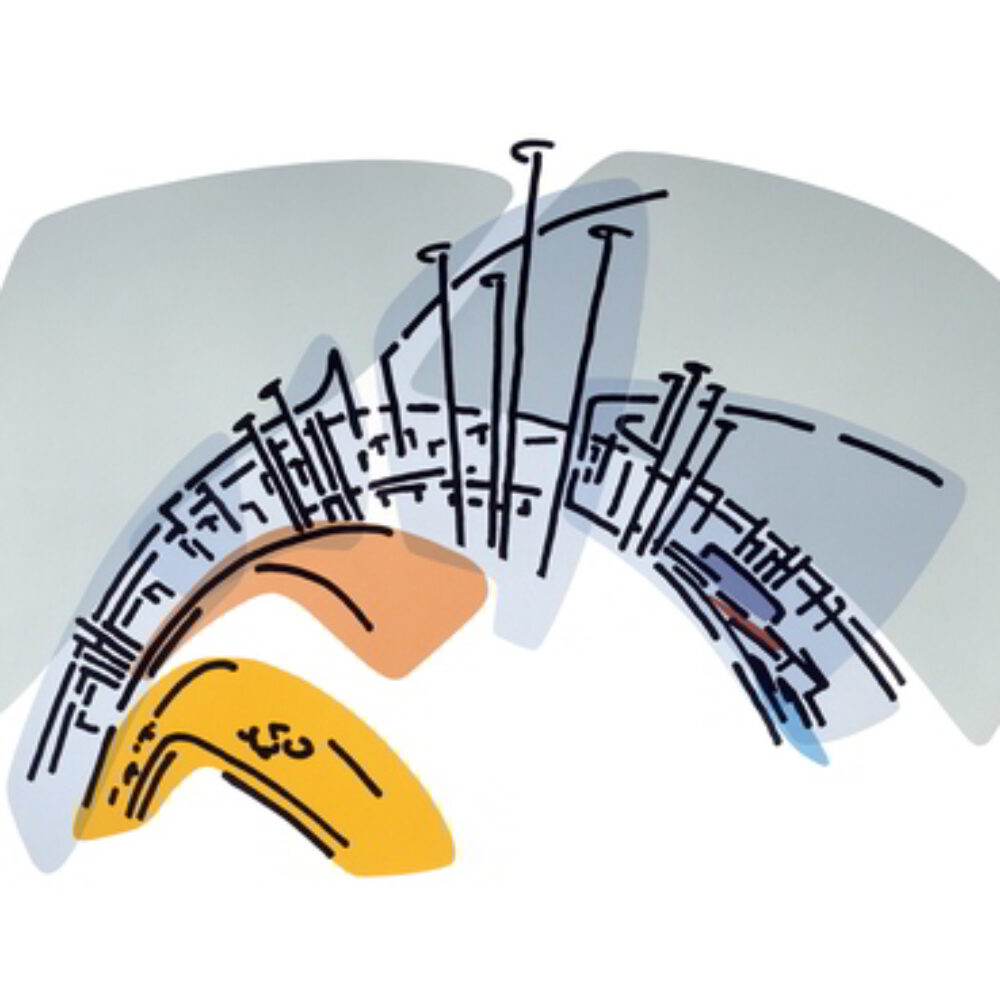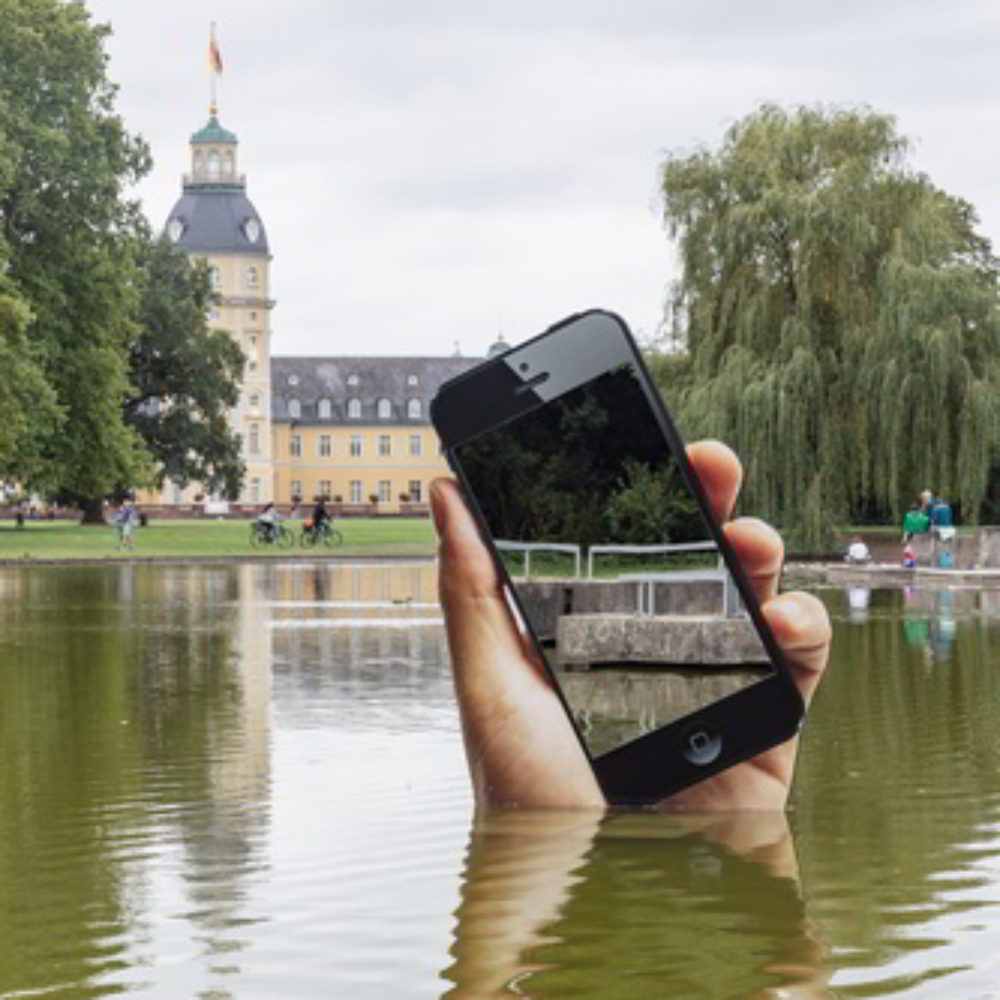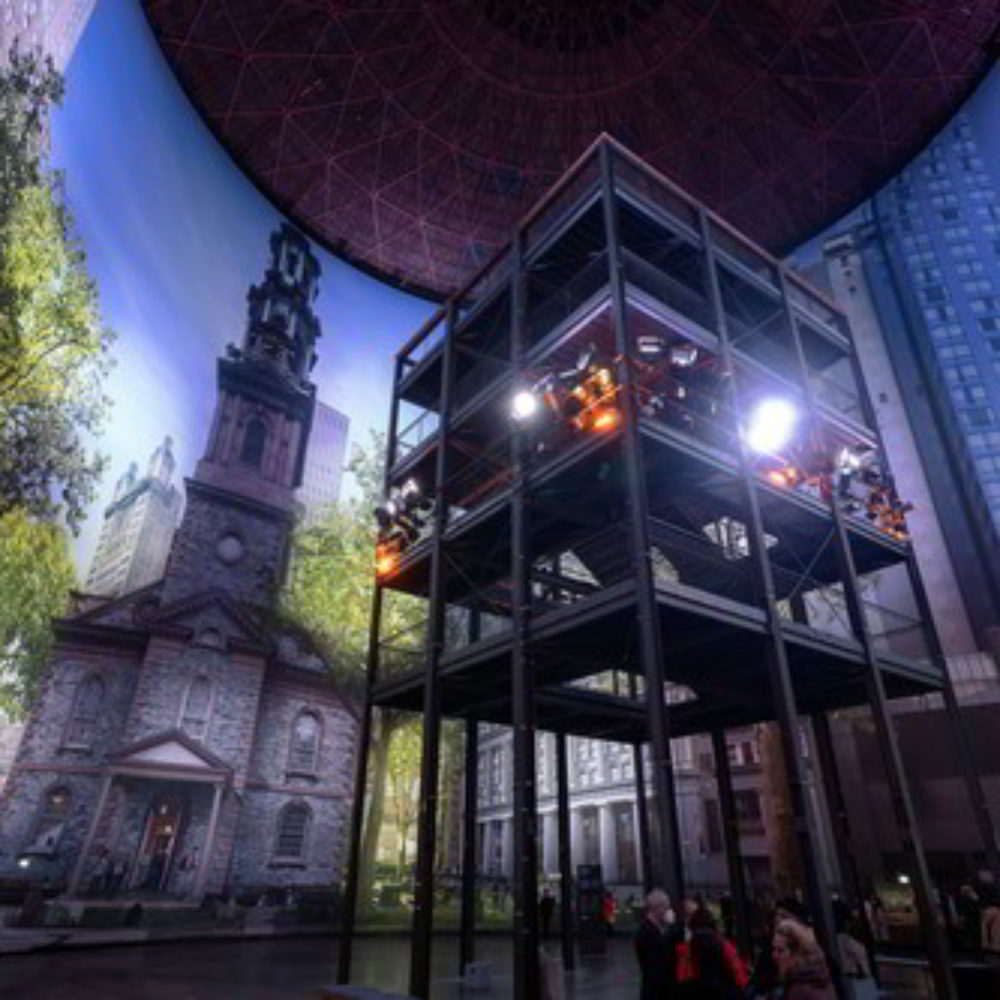Sie ist eine der international prominentesten Figuren der Gegenwartskunst: Yayoi Kusama. Vom 23. April bis 15. August 2021 zeigt der Gropius Bau in Berlin eine Ausstellung ihrer Werke aus acht Jahrzehnten. Es ist die erste umfassende Retrospektive der Japanerin in Deutschland.
7. Mai 2021 | Özlem Özdemir
Y
ayoi Kusama ist eine fulminante Erscheinung der internationalen Gegenwartskunst, und von gleicher Qualität ist auch der Titel ihrer diesjährigen Ausstellung in Berlin, benannt nach ihrer Installation von 2021. Er klingt gigantisch, geheimnisvoll und poetisch: A Bouquet of Love I Saw in the Universe.
Die heute 92-jährige Künstlerin hat dieses „Bouquet“ eigens für das große historische Atrium des Gropius Baus entworfen. Heiter und gespenstig streben riesige aufblasbare Krakenarme in Richtung Glasdach. Man könnte auch sagen, es sind tanzende Schlangen, wogende Gräser, züngelnde Flammen, büschelige Seeanemonen, oberirdische Riesenwurzeln, wirbelnde Galaxien. Denkbar wären auch herausquellende Dämonen oder brodelnde Science-Fiction-Wesen. Einfacher zu beschreiben sind die schwarzen Punkte. Sie sind das Kusama-Kennzeichen: Polka Dots. In verschiedenen Formaten und mehreren Reihen zieren sie das pinkfarbene Material. Sie lassen das Reglose visuell pulsieren und akzentuieren das spitze Zulaufen der schlauchartigen Körper, die in Richtung Himmel und Licht weisen. Dasselbe Muster und dieselbe Farbe finden sich auf dem Boden. Exponat und Fundament gehen ineinander über. Ausweitung und Auflösung liegt in der Luft. Beim Wandeln und Treiben durch das Werk lässt sich trefflich sinnieren. Das Endlose des Meeres, die unschätzbare Weite des Raums, das Umsichgreifen von vernetzten Systemen – all das wird heraufbeschworen. Wie ein explosives Credo steht das Werk im Zentrum des Ausstellungsorts. In voller Blüte in Pink streckt Kusama es uns entgegen, ihr Arrangement von Assoziationen, das changiert zwischen floristisch, animalisch und kosmisch.
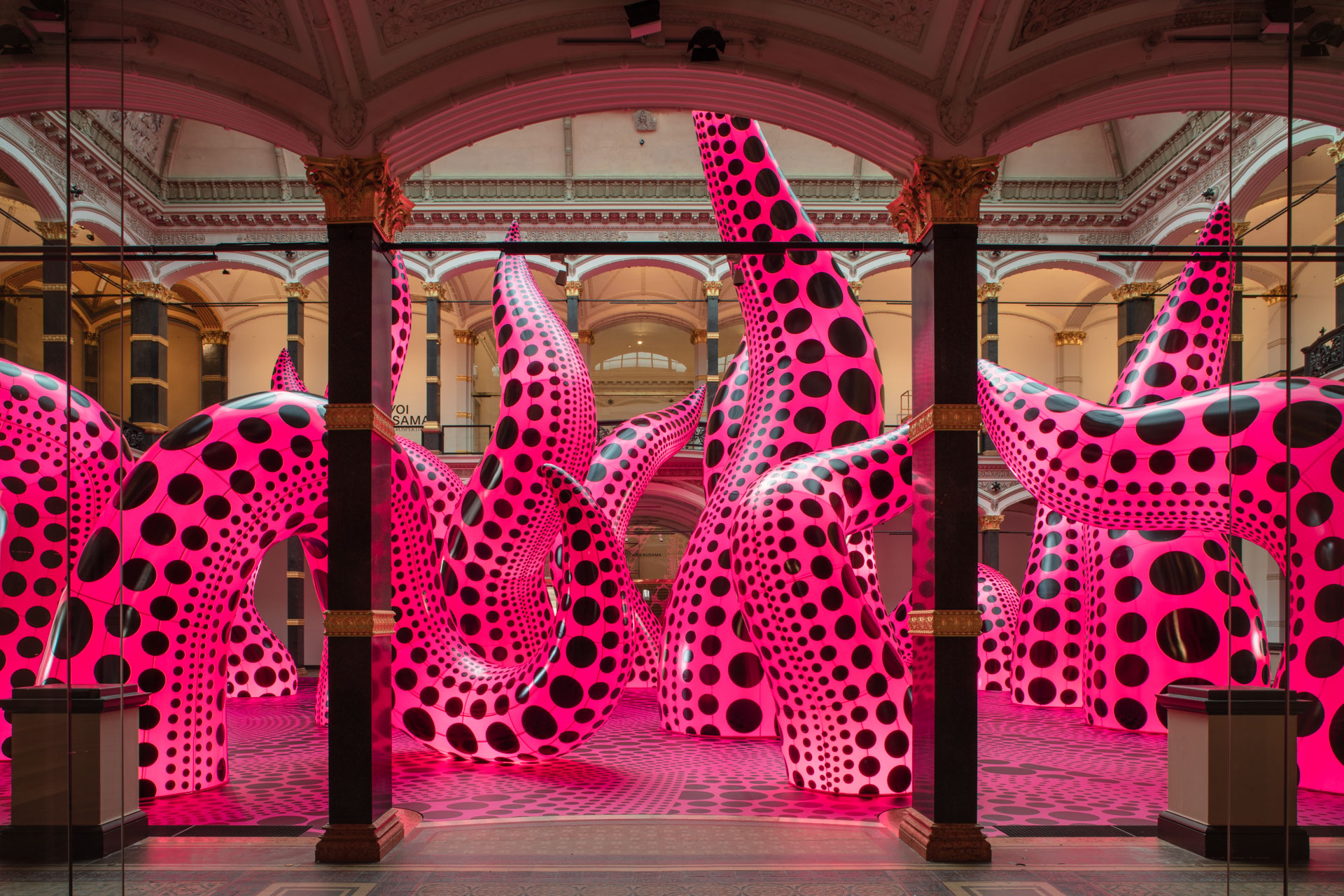
Wer ist die Schöpferin dieses grandiosen Ausstellungsauftakts? Yayoi Kusama, die weithin als die bedeutendste Künstlerin der japanischen Nachkriegszeit gilt, wurde 1929 in Matsumoto, Japan, geboren. Nach einer Aufforderung von Georgia O’Keefe, der sie als Bewunderin und Ratsuchende geschrieben hatte, kam sie 1957 in die USA, machte dort Karriere, wurde auch in Europa bekannt und kehrte 1973 wieder zurück nach Japan. Seit 1977 lebt sie, u.a. aufgrund eines Nervenleidens, freiwillig in einer psychiatrischen Einrichtung in Tokio. Gleichzeitig arbeitet sie weiterhin in ihrem Atelier an ihrem Schaffensspektrum, das von Kunst über Film und Mode bis hin zur Literatur reicht.
Nach eigenen Angaben begann Yayoi Kusama schon als Kind zu malen. Damals erlitt sie furchterregende Halluzinationen: So erschienen ihr die Felder, von denen ihr Zuhause umgeben war, wie ein allumfassendes, expandierendes gesprenkeltes Muster, das sich vom Himmel bis zur Erde erstreckte, sie erfasste und zu verschlingen drohte. Und wie diese grenzauflösende Erfahrung wurde eine Grenzüberschreitung ganz anderer Art zu einem weiteren Ausschlaggeber für ihr zukünftiges Schaffen: Als Kusama ein kleines Mädchen war, ließ sie die Mutter, die Kusamas Vater einer Affäre verdächtigte, das Liebespaar ausspionieren und Bericht erstatten. Der ausgeführte Auftrag lies die Tochter traumatisiert zurück. Die Extremsituationen ihres Lebens hatten schöpferische Konsequenzen.
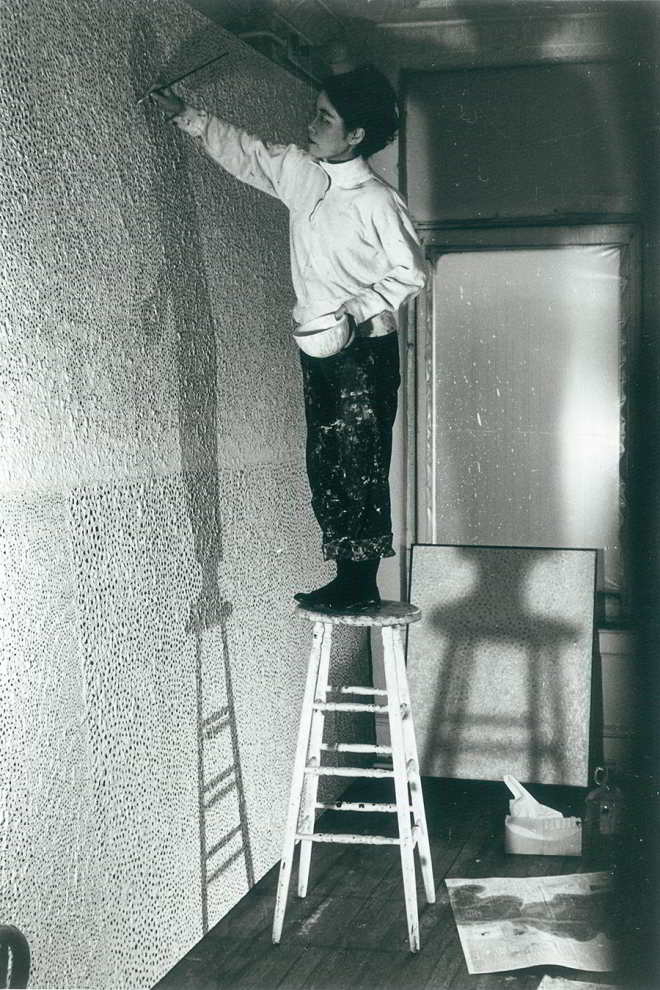
In den 50er-Jahren begann Kusama ihre alles umhüllenden Visionen in riesige, akribisch gemalte Infinity Net Gemälde zu übertragen. Ihre erste Arbeit dieser monoton-hypnotischen Art, bestehend aus kleinen Kreisen auf übergroßen Leinwänden, wurde 1959 in New York ausgestellt. Der Entstehungsprozess dieser Bilder war eine Form der Katharsis für sie: Mit dem Akt der Wiederholung versuchte sie, ihre Ängste und sogar sich selbst auszulöschen.
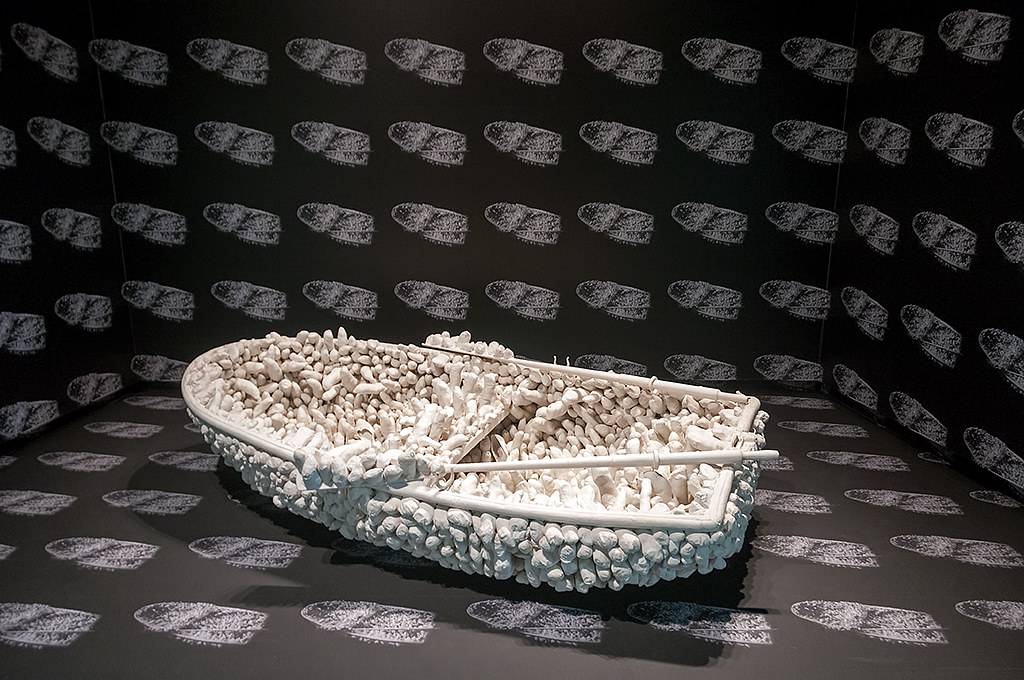
One Thousand Boats Show von 1963 ist eine ihrer Akkumulationen (oder Aggregationen), worin sie Möbel, Böden und andere Gegenstände von weichen Formen, die männliche Glieder darstellen, überwuchern lässt. Bei diesem Stück ist es ein Ruderboot, das sie derart behandelt, sowohl innen als auch außen. Gefährt und Glieder sind quasi in weißer Farbe vereint. Die Raumwände sind schwarz und verziert mit gleichmäßig verteilten identischen Fotokopien davon. (Andy Warhol, dem sie später vorwarf, ihre Ideen zu stehlen, verwendete bei einer Ausstellung 1966 eine Tapete ähnlicher, wenn auch in farbiger Version. Das überbordend männlich besetzte Boot der Kusama ersetzte er durch einen sich wiederholenden Siebdruck mit einem sehr weiblichen Motiv: dem Porträt einer Kuh.)
“By translating hallucinations and fear of hallucinations into paintings, I have been trying to cure my disease”1, sagt die Künstlerin in einem Interview. Und in einem Gespräch mit Andrew Solomon, einem promovierten Psychologen, gibt sie preis: „I was afraid of sex. I don’t do any sex. Never. The sexual obsession and the fear of sex sit side by side in me.”2 Kusama ist Meisterin in der Verwandlung ihrer Ängste: Heraus kommt eine Welt der Faszination, wenn nicht sogar Entertainment.

Infinity Mirror Room – Phalli’s Field (1965) ist hierfür ein berühmtes Beispiel. Der eigens für die New Yorker Ausstellung Floor Show konstruierte Spiegelraum maß in der Höhe etwas mehr als zweieinhalb Meter und hatte eine Grundfläche von 25 Quadratmetern. Die vier durchgehend verspiegelten Wände führten zu Endlos-Reflexionen der Betrachter. Der Boden des Raumes war fast restlos mit einem Teppich aus weichen Stoffausstülpungen bedeckt. Diese von Kusama aus rot-weißem polka-dot-bedrucktem Baumwollstoff hergestellten Säcke waren mit Watte ausgestopft. Sie mussten so verpackt sein, dass sie straff und aufrecht stehen konnten³. So baut sich Kusma ein „Erfahrungsfeld“, das sie unterschiedlich „bespielen“ kann (mal liegend und mal stehend und immer in unterschiedlicher Kleidung).
Infinity Mirror Room – Phalli’s Field ist Kusama’s erstes Werk, in dem sie den Spiegel verwendet. Befreit von dem phallischen Teppich, konzentriert sie sich in ihren späteren Spiegelarbeiten immer mehr auf das bloße Phänomen der Spiegelungen und der irritierend grenzenlosen Vervielfältigungen von Raum und Mensch, kombiniert mit sich vermehrenden Mustern etwa aus Kreisen und Kugeln. Einige dieser Spiegelkabinette à la Kusama sind im Gropius Bau aufgebaut. Außerdem gibt es eine weitere Version des Infinity Mirror Room, die eigens für diese Ausstellung enstand: The Eternally Infinite Light of the Universe Illuminating the Quest for Truth. Eines haben sie alle gemeinsam: Sie laden zum Eintauchen ein und fordern dazu auf, sich zu verlieren und dabei zu entdecken.
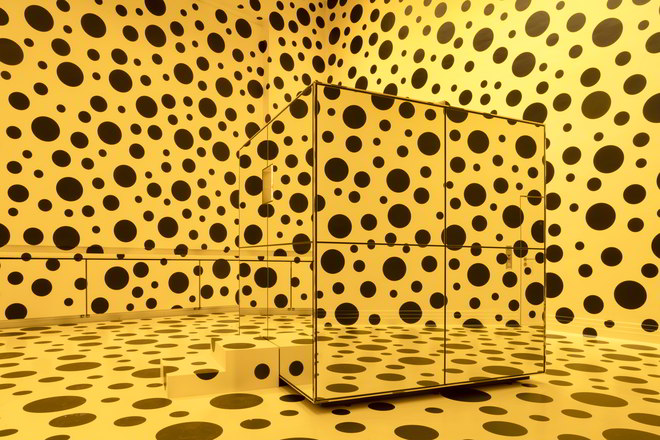
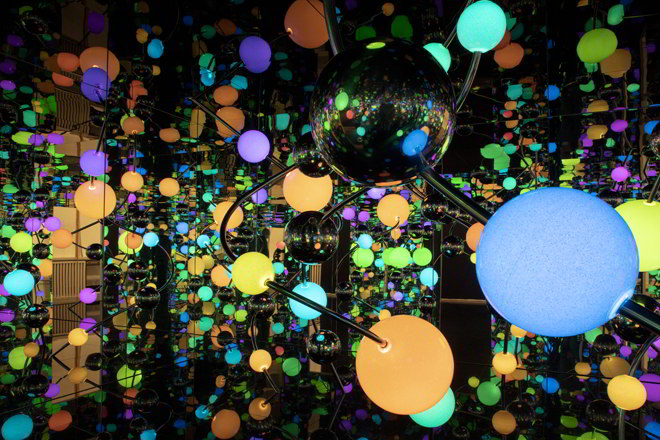
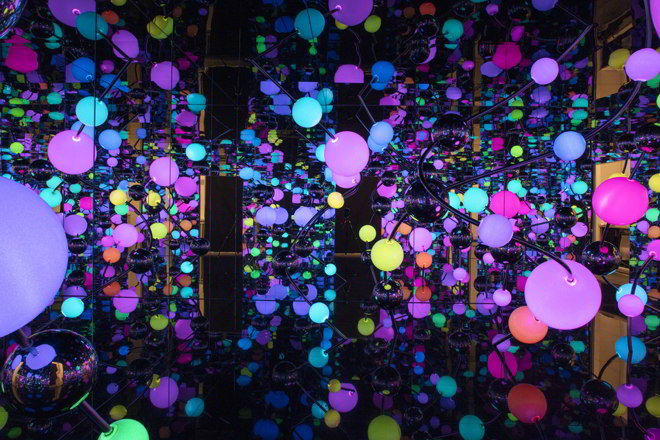
Passend zu Kusamas Visionen übergriffiger Grenzenlosigkeit gibt es bei dieser Ausstellung der visuell-körperlichen Entdeckungen unendlich viel. Genauso mannigfaltig sind die Möglichkeiten, sie kunsthistorisch einzuordnen. Gilda Williams, ausgewiesene Kennerin von Warhol (Kusamas „kopierender Kollege“), staunt in ihrem Essay Infinite Nature: On Yayoi Kusama’s Pumpkins4 über diese lange Schaffenszeit, in der sie viele kunsthistorische Momente vorweggenommen hätte. Laut Williams produzierte Kusama großformatige weiche Skulpturen noch vor Claes Oldenburgs Soft Sculptures, schuf Akkumulationsskulpturen mit repetitiven Formen noch vor ihrer Freundin Eva Hesse, deren Werk vom Prinzip der Wiederholungen lebt, fabrizierte phallusbestückte Objekte noch vor Louise Bourgeois und sie erdachte Tapeten mit sich wiederholenden Formen sowie silbrige Objekte noch vor Andy Warhol. Auch Kusamas Einfluss auf die Gegenwartskunst ist frappierend, siehe die psychotisch wirkenden Videos der Pipilotti Rist oder die bunten Punkt-Obsessionen bei Damien Hirst.
A Bouquet of Love I Saw in the Universe ist die erste institutionelle Kusama-Retrospektive in Deutschland. Allein das ist schon erstaunlich. Eine Entschädigung für die Verspätung: Die Ausstellung erstreckt sich über fast 3000 m² und zeigt fast 300 Werke aus den letzten 80 Jahren. Kuratorin der superlativen Präsentation ist Stephanie Rosenthal, Direktorin des Gropius Bau. Sie arbeitete eng mit der Künstlerin und ihrem Atelier in Tokio zusammen. Man stützte sich weitgehend auf Kusamas eigenes Archiv, das Rosenthal und ihr Team persönlich besucht haben. Ausgewählt wurden Gouachen auf Papier, akkumulative Skulpturen, Happenings und Modearbeiten. Lichtblicke sind auch Kusamas jüngste Gemälde.
Die Eröffnung der Ausstellung war ursprünglich früher geplant. Aber ein Leid von geradezu kusamascher Dimension brach weltweit aus. Wegen einer Pandemie jedoch den Berliner Auftritt einer Künstlerin, die das Londoner Christie’s zu den Titanen der Pop-Art zählt, nicht zu besuchen, ist keine Entschuldigung. Der Gropius Bau bietet einen Digital Guide5 mit lebendigen Einblicken und geistigen Appetithäppchen. Eines der gezeigten Fotos ist seltsam berührend. Die Rede ist von der Schwarz-Weiß-Aufnahme, die die Grande Dame der zeitgenössischen Kunst als 10-jähriges Kind zeigt. Sie hält einen großen Blumenstrauß in der Hand. Fast nur ihr Gesicht schaut hervor. Es ist ernst und starr. Mehr noch, es wirkt wie versteinert – vielleicht vor Verletztheit, vielleicht vor Langmut. Dieses junge Gesicht ist von ähnlicher Größe wie die Blüten um sie herum. Das Mädchen reiht sich ein in die florale Komposition, verschmilzt mit ihr und ragt doch hervor. Das Ganze erscheint einem wie ein irdisches und doch transzendentes Andachtsbild, eine Ikone. Die Worte daneben sind Kusama-Feeling pur: „Auch wenn die Vollendung der vor mir liegenden Arbeit vierhundert Jahre dauern würde, ich würde genau in diesem Moment damit beginnen – so fühle ich mich.“6 ♦
¹ https://bombmagazine.org/articles/yayoi-kusama; letzter Zugriff 4.5.2021
² https://www.artforum.com/print/199702/dot-dot-dot-the-lifework-of-yayoi-kusama-32905; letzter Zugriff 4.5.2021
³ Angaben nach: Applin, J. (2012). Yayoi Kusama: Infinity Mirror Room – Phalli’s Field. London: Afterall Publishing.
⁴ Gilda Williams: Infinite Nature: On Yayoi Kusama’s Pumpkins in Ausst.-Kat. Yayoi Kusama – Pumpkins; Published October 31st 2014 by Victoria Miro Gallery
5 https://kusama-digital-guide.gropiusbau.de/de; letzter Zugriff 4.5.2021
6 Yayoi Kusama: Infinity Net. Meine Autobiographie; Bern/Wien 2017
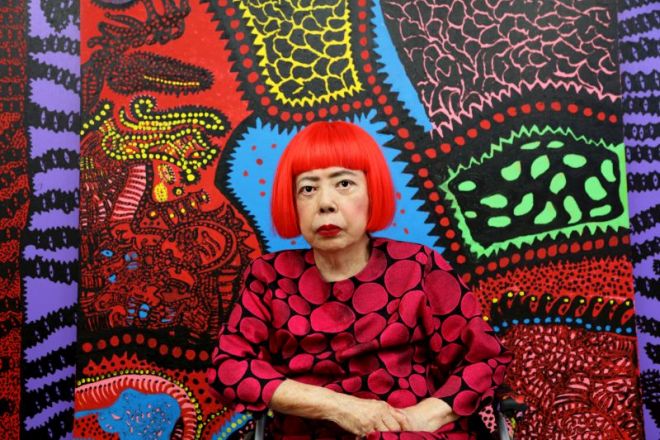
Zur Website von
GROPIUS BAU
Yayoi Kusama: A Retrospective. A Bouquet of Love I Saw in the Universe
She is one of the most prominent international figures in contemporary art: Yayoi Kusama. From 23 April to 15 August 2021, the Gropius Bau in Berlin displays an exhibition of her works from eight decades. It is the first comprehensive retrospective of the Japanese artist in Germany.
Yayoi Kusama is a fulminant phenomenon of international contemporary art, and of equal quality is the title of her exhibition in Berlin this year, named after her installation of 2021. It sounds gigantic, mysterious and poetic: A Bouquet of Love I Saw in the Universe.
The artist, who is now 92 years old, designed this „bouquet“ especially for the large historic atrium of the Gropius Bau. Cheerful and ghostly, huge inflatable octopus arms strive toward the glass roof. One could also say they are dancing snakes, waving grasses, lambent flames, tufted sea anemones, giant above-ground roots, swirling galaxies. Conceivable would also be outpouring demons or seething science fiction beings. Easier to describe are the black flecks. They are the Kusama trademark: polka dots. In various formats and several rows, they adorn the pink material. They make the motionless visually pulsate and accentuate the tapering of the tube-like bodies, which point towards the sky and light. The same pattern and the same colour are found on the floor. Exhibit and foundation merge into one another. Expansion and dissolution are in the air. While wandering and drifting through the work, some excellent musings can be made. The endlessness of the sea, the inestimable expanse of space, the encirclement of networked systems – all this is conjured up. Like an explosive credo, the work stands in the centre of the exhibition space. In full bloom in pink, Kusama stretches it out towards us, her arrangement of associations that oscillates between floristic, animalistic and cosmic.
Who is the creator of this terrific exhibition kick-off? Yayoi Kusama, widely regarded as the most significant artist of post-war Japan, was born in Matsumoto, Japan, in 1929. Following a call from Georgia O’Keefe, to whom she had written as an admirer and seeker of advice, she came to the USA in 1957, made a career there, became known in Europe as well and returned to Japan in 1973. Since 1977 she has been living voluntarily in a psychiatric institution in Tokyo, partly due to a nervous condition. At the same time, she continues to work in her studio on her creative repertoire, which ranges from art to film and fashion to literature.
According to her own account, Yayoi Kusama began painting as a child. At that time, she suffered terrifying hallucinations: Thus, the fields that surrounded her home appeared to her like an all-encompassing, expanding speckled pattern that stretched from sky to earth, seizing her and threatening to engulf her. And like this boundary-dissolving experience, a border crossing of a completely different kind became a further trigger for her future work: When Kusama was a little girl, her mother, suspecting Kusama’s father of an affair, had her spy on the lovers and report back. The mission carried out left the daughter traumatized. The extreme situations of her life led to creative consequences.
In the 1950s, Kusama began to translate her all-enveloping visions into huge, meticulously painted Infinity Net paintings. Her first work of this monotonously hypnotic kind, consisting of small circles on oversized canvases, was exhibited in New York in 1959. The process of creating these paintings was a form of catharsis for her: With the act of repetition, she tried to extinguish her fears and even herself.
One Thousand Boats Show from 1963 is one of her accumulations (or aggregations) in which she allows furniture, floors and other objects to be overgrown by soft forms representing male organs. In this piece, it is a rowing boat that she treats in this way, both inside and out. Boat and organs are virtually united in white. The walls of the room are black and decorated with evenly distributed identical photocopies of it. (Andy Warhol, whom she later accused of stealing her ideas, used a wallpaper similar to hers, albeit in a coloured version, at an exhibition in 1966. He replaced Kusama’s overflowingly masculine boat by a repetitive screen print with a very feminine motif: the portrait of a cow.)
„By translating hallucinations and fear of hallucinations into paintings, I have been trying to cure my disease“1, says the artist in an interview. And in a conversation with Andrew Solomon, a psychologist who has a doctorate, she reveals: „I was afraid of sex. I don’t do any sex. Never. The sexual obsession and the fear of sex sit side by side in me.“2 Kusama is a master at transforming her fears: out comes a world of fascination, if not entertainment.
Infinity Mirror Room – Phalli’s Field (1965) is a famous example of this. Constructed especially for the New York exhibition Floor Show, the mirror room measured just over two and a half metres in height and had a floor space of 25 square metres. The four continuously mirrored walls led to endless reflections of the viewers. The floor of the room was almost completely covered with a carpet of soft fabric protrusions. These pouches, made by Kusama from red and white polka-dot printed cotton fabric, were stuffed with cotton wool. They had to be packed so that they could stand taut and upright³. In this way, Kusama builds a „field of experience“ for herself, which she can „play on“ in different ways (sometimes lying and sometimes standing and always in different clothes).
Infinity Mirror Room – Phalli’s Field is Kusama’s first work in which she uses the mirror. Freed from the phallic tapestry, in her later mirror pieces she concentrates more and more on the mere phenomenon of reflections and the irritatingly boundless multiplications of space and people, combined for example with multiplying patterns of circles and spheres. Some of these mirror cabinets à la Kusama are set up in the Gropius Bau. What’s more, there is another version of the Infinity Mirror Room, created especially for this exhibition: The Eternally Infinite Light of the Universe Illuminating the Quest for Truth. One thing they all have in common: they invite you to dive in and challenge you to lose yourself and, in the process, to make discoveries.
In keeping with Kusama’s visions of encroaching boundlessness, this show is filled with limitless visual-physical discoveries. Likewise, the possibilities of classifying them in terms of art history are manifold. Gilda Williams, a proven connoisseur of Warhol (Kusama’s „copying colleague“), marvels in her essay Infinite Nature: On Yayoi Kusama’s Pumpkins4 at this long creative period, stating that it anticipated many art historical moments. According to Williams, Kusama produced large-scale malleable sculptures before Claes Oldenburg’s Soft Sculptures, created accumulation sculptures with repetitive forms before her friend Eva Hesse, whose work lives on the principle of repetition, made phallus-tipped objects before Louise Bourgeois, and devised wallpaper with repetitive forms and silvery objects before Andy Warhol. Another striking influence of Kusama can be found in contemporary art, such as the psychotic videos of Pipilotti Rist or the colourful dot obsessions of Damien Hirst.
A Bouquet of Love I Saw in the Universe is the first institutional Kusama retrospective in Germany. That alone is amazing. Compensation for the delay: the exhibition covers almost 3000 m² and shows almost 300 works from the last 80 years. The curator of the superlative presentation is Stephanie Rosenthal, director of the Gropius Bau. She worked closely with the artist and her studio in Tokyo. Much was drawn from Kusama’s own archive, which Rosenthal and her team visited in person. The selected works encompass gouaches on paper, accumulative sculptures, happenings and fashion works. Among the highlights of the show are Kusama’s most recent paintings.
The opening of the exhibition was originally planned earlier. But an affliction of almost Kusamashian dimensions broke out worldwide. However, to not visit the Berlin appearance of an artist whom the London Christie’s counts among the titans of Pop Art due to a pandemic is no excuse. The Gropius Bau offers a Digital Guide5 with lively insights and intellectual appetizers. One of the photos shown is strangely touching. We are talking about the black-and-white photograph showing the Grand Dame of contemporary art as a 10-year-old child. She is holding a large bouquet in her hand. Almost only her face peers out. It is serious and stiff. Even more, it seems petrified – perhaps with hurt, perhaps with longanimity. This young face is of similar size to the surrounding flowers. The girl joins the floral composition, merges with it and yet stands out. The whole thing seems like an earthly yet transcendent devotional image, an icon. The words next to it are pure Kusama feeling: „Even if the work before me were to require four hundred years to complete, I would begin this very moment – that is how I feel.“6
TRANSLATION BY ÖZLEM ÖZDEMIR
1 https://bombmagazine.org/articles/yayoi-kusama; last access date 4.5.2021
2 https://www.artforum.com/print/199702/dot-dot-dot-the-lifework-of-yayoi-kusama-32905; last access date 4.5.2021
3 According to: Applin, J. (2012). Yayoi Kusama: Infinity Mirror Room – Phalli’s Field. London: Afterall Publishing.
4 Gilda Williams: Infinite Nature: On Yayoi Kusama’s Pumpkins in Ausst.-Kat. Yayoi Kusama – Pumpkins; Published October 31st 2014 by Victoria Miro Gallery
5 https://kusama-digital-guide.gropiusbau.de/en; last access date 4.5.2021
6 Yayoi Kusama: Infinity Net. Meine Autobiographie; Bern/Wien 2017




